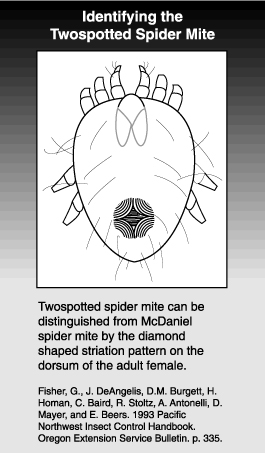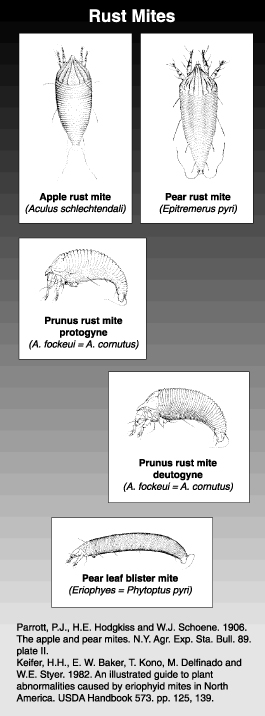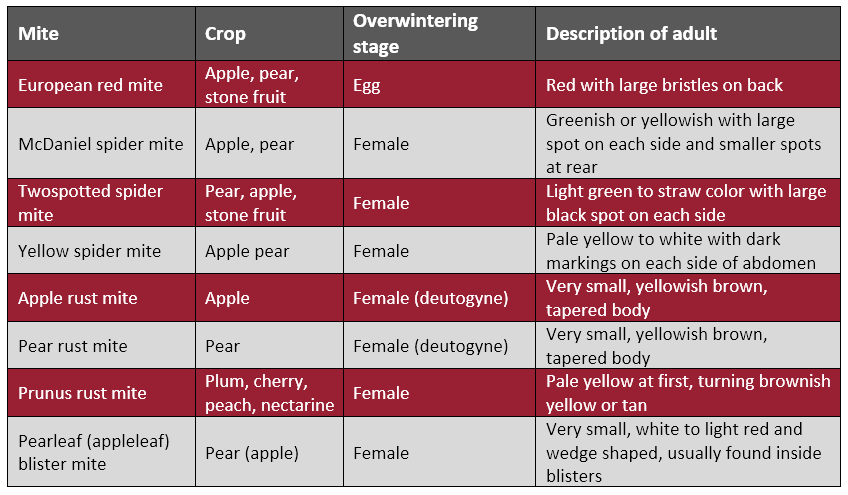by Elizabeth Beers and Rebecca Schmidt-Jeffris, updated 2014
(Acari: Tetranychidae, Eriophyidae, Phytoseiidae, Stigmaeidae)
Mites are not insects, although in agricultural contexts they are often discussed with insects for convenience. They are more closely related to spiders than insects. Both mites and insects are in the phylum Arthropoda (see section on Animal Classification in IPM Concepts), which is why the term “beneficial arthropods” is used to refer to parasitic or predatory insects, mites and spiders. The order to which mites belong (the Acari) is the root for the term “acaricide.”
Most insects have three pairs of legs and three major body parts, whereas mites have two body regions (cephalothorax and abdomen) and can have two, three or four pairs of legs. Many adult insects have wings, but mites never do. Mites are extremely numerous and are found in many kinds of habitats. Their small size makes them difficult to detect, identify, and monitor. The mites that attack fruit trees in the United States fall mainly into two groups: spider mites (Tetranychidae) and rust mites (Eriophyidae).
Tetranychids
 Overall, the spider mites are one of the largest, most important and most destructive groups of pests in agriculture. Spider mites are less than 0.5 mm (1/50 inch) long, and adults can just be seen with the naked eye. The word “spider” in their name refers to their ability to spin webs. McDaniel spider mite is a prolific web spinner, twospotted mite is intermediate, and European red mite produces only a modest amount of webbing.
Overall, the spider mites are one of the largest, most important and most destructive groups of pests in agriculture. Spider mites are less than 0.5 mm (1/50 inch) long, and adults can just be seen with the naked eye. The word “spider” in their name refers to their ability to spin webs. McDaniel spider mite is a prolific web spinner, twospotted mite is intermediate, and European red mite produces only a modest amount of webbing.
Eriophyids
Rust mites are more elongated and about half the length of spider mites. They can be seen only under magnification. They are somewhat wedge-shaped and have only two pairs of legs at the front end of the body. These mites are usually host specific in that they attack only one species (monophagous) or a related group of species (oligophagous). Their host plants are primarily perennials. Rust mites can be divided into two ecological groups: the “free-living rust mites” (e.g., apple rust mite, pear rust mite, and prunus rust mite), and the gall-forming mites (e.g., pearleaf and appleleaf blister mite). The latter spend their life inside a gall which is produced in response to their salivary toxins.
 Eriophyids are also the only important group of mites that transmits plant viruses; the sole tree fruit example is Eriophyes inaequalis, the vector of cherry leaf mottle virus. Mites from all of these groups attack tree fruits.
Eriophyids are also the only important group of mites that transmits plant viruses; the sole tree fruit example is Eriophyes inaequalis, the vector of cherry leaf mottle virus. Mites from all of these groups attack tree fruits.
Like the spider mites, rust mites also suck plant juices, but their feeding causes a silvering or brownish cast on leaves and russeting of fruit. In contrast, the spider mites (which also suck plant juices) cause stippling, a series of white dots on the leaf where chlorophyll has been removed; as the leaves age or damage increases, the leaf takes on an overall brownish cast. On pear, the latter stages of spider mite damage cause the leaf to turn a solida dark brown or black.
Biology of tree fruit rust mites
Eggs
Rust mite eggs are extremely small, roughly hemispherical, and require 100-power or greater magnification to be seen.
Immatures
Rust mites have two nymphal instars. All stages of immatures and adults have two pairs of legs at the front end of the body, and an elongate abdomen (hystersoma) with many striations appearing as rings. This appearance is referred to as annulate.
Adults
Adult females occur in two forms: deutogynes and protogynes. Deutogynes are a special form of female that overwinters. The differences between these two forms make species identification difficult. Protogynes are the normal females, which occur throughout much of the growing season and reproduced immediately upon becoming adults. These are the forms on which species identifications are usually based. Males also occur in the species that attack tree fruits, but do not overwinter. They are slightly smaller but are similar in appearance to the protogynes.
Life history
Rust mites overwinter as inseminated deutogynes. These females do not reproduce in the year in which they are produced. Some chilling is required before they will lay eggs in the spring. As with protogynes, these eggs produce both males and females. The rust mite has two nymphal instars, which resemble the adult but are smaller. Each molt is preceded by a quiescent phase. Male rust mites are produced by unfertilized eggs and females are produced by fertilized eggs (arrhenotokous parthenogenesis). They do not actually mate. The males deposit stalked spermatophores (structures containing a packet of sperm) on the leaves. Females walk over a spermatophore and empty it of the sperm, storing it in a special pouch called a spermatheca. Both sexes will be produced from eggs when females have access to spermatophores. Multiple overlapping generations are produced during the year, the number depending on the climate, location and condition of the host. The hibernating forms (deutogynes) are produced in response to either poor host condition or climatic conditions (cool weather, shorter photoperiod) that occur in the fall.
Predatory mites
Not all mites that occur on tree fruits are pests. Several mite species prey on pest mites. The most important predatory mites in the Pacific Northwest fall into two families: the Phytoseiidae, which includes Typhlodromus occidentalis (also known as Metaseiulus occidentalis and Galandromus occidentalis) and Typhlodromus pyri; and the Stigmaeidae, which includes Zetzellia mali. The phytoseiids are a family of very important predatory mites and contain species which provide biological control of mites all over the world. The stigmaeids are much less important in terms of distribution and total impact. Both species of Typhlodromus mites will attack spider mites and rust mites, and Z. mali will attack European red mite and rust mites.
Relationships between the mite species are complex, and control of one may affect populations of another. Orchard mites have several natural enemies, but some broad-spectrum pesticides used for insect control can reduce or eliminate them. For that matter, many acaricides (miticides) have been as toxic or more toxic to predatory mites than to pest mites. Orchardists can effectively adopt practices (both in terms of chemical choices and cultural practices) that will allow predator populations to thrive. While this might not immediately solve mite problems, it can lead to more stable, long-term mite control and eliminate or slow the development of resistance to miticides.

